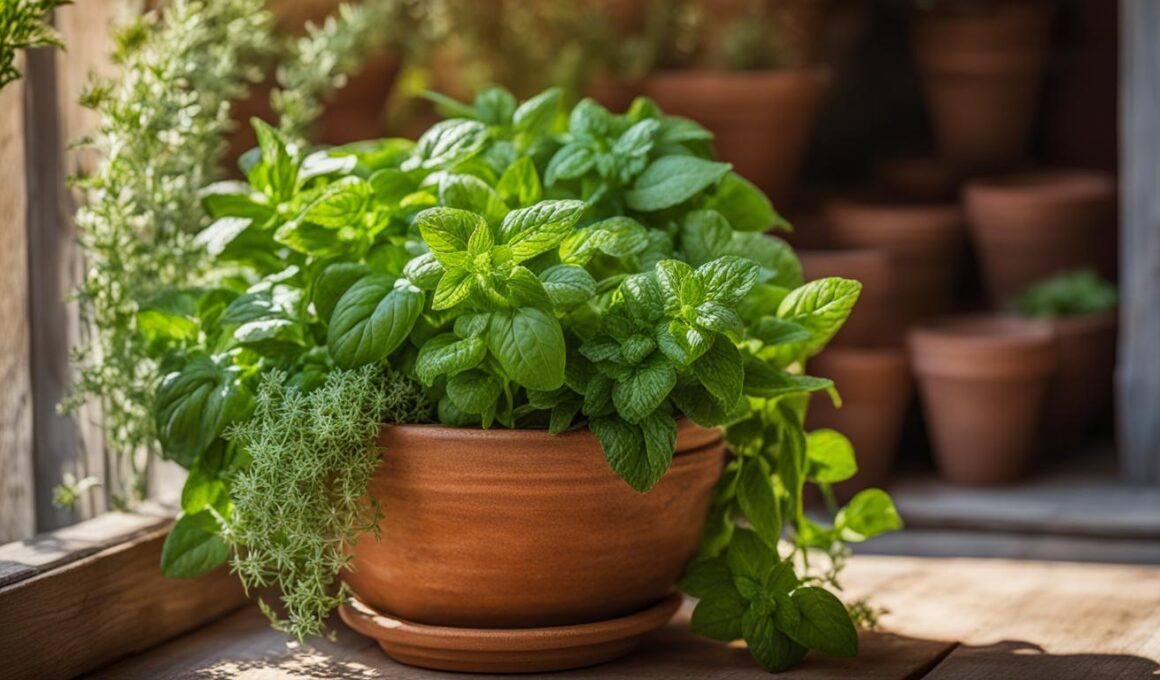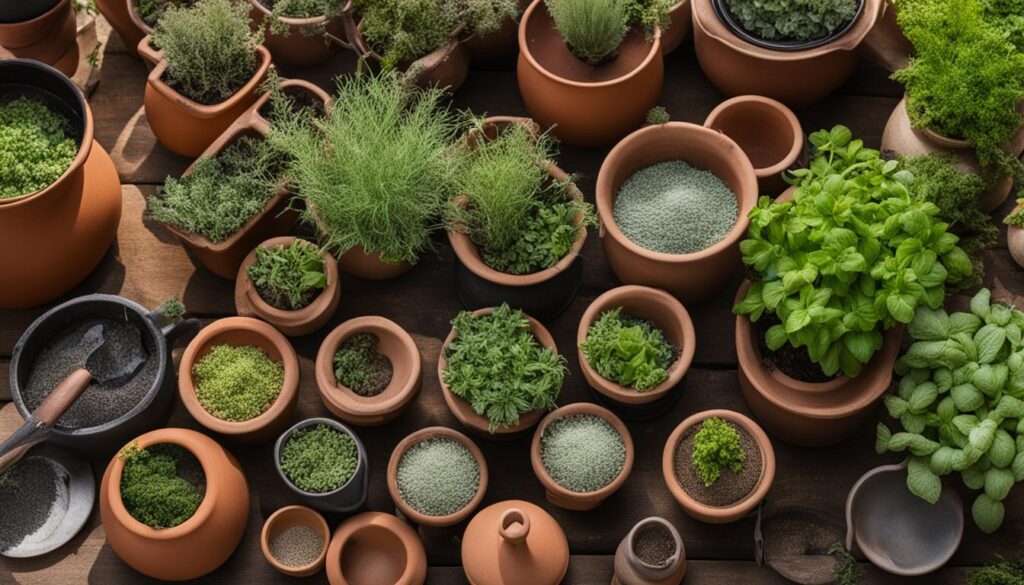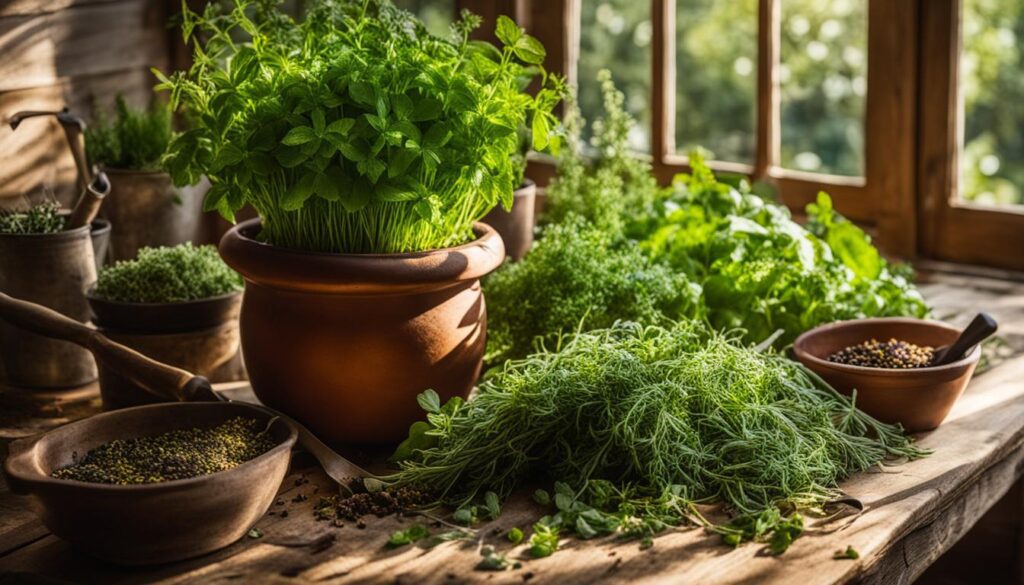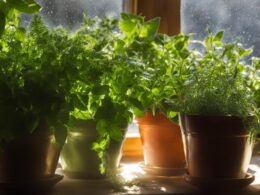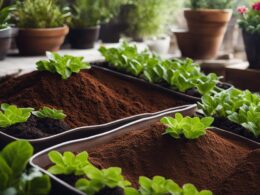Are you interested in growing a diverse herb garden but limited on space? Look no further than the convenience of growing multiple herbs in one pot. This ultimate guide will provide you with all the information you need to create a thriving herb garden in a single container.
Planting multiple herbs in one pot not only saves space but also offers several benefits. When herbs share a growing season and require the same amount of light, water, and nutrition, they thrive together. Companion planting in one pot reduces water evaporation, slows down the spread of diseases, and can even enhance the taste of certain crops.
Before getting started, it’s essential to consider your local gardening climate. Knowing which herbs can be grown together in one pot depends on the conditions they thrive in. Moisture-loving herbs like basil, parsley, and lemon balm can be planted together as long as the soil is moist but not waterlogged. Mediterranean herbs such as rosemary, thyme, oregano, and sage prefer drier soil and full sun conditions. Mint herbs, on the other hand, are best grown in a separate container due to their invasive nature, but different varieties of mint can be grown together.
Ultimately, choose herbs that you enjoy cooking with and have similar growing needs to plant together in one pot. With the right selection and proper care, you can create a bountiful herb garden that will enhance your culinary creations.
Key Takeaways
- Growing multiple herbs in one pot saves space and offers several benefits, such as companion planting and enhanced flavors.
- Consider your local gardening climate and choose herbs with similar growing needs to plant together in one pot.
- Moisture-loving herbs and Mediterranean herbs have different soil and sunlight requirements, so it’s important to group them accordingly.
- Avoid planting invasive herbs like mint with other herbs and choose separate containers for them.
- Experiment with different combinations of herbs to find what works best for your taste and gardening conditions.
Selecting the Right Pot for Herb Gardening
When it comes to growing herbs in one pot, choosing the right pot is essential for the health and success of your plants. Consider the size, material, and drainage system of the pot to create an optimal growing environment.
First, determine the appropriate pot size based on the type of herbs you plan to grow. Smaller pots (6-8 inches) are suitable for herbs like basil, chives, oregano, thyme, and parsley. Medium-sized pots (8-12 inches) work well for mint, rosemary, sage, cilantro, and dill. For larger herbs like lavender, lemon balm, tarragon, and bay leaf, opt for larger pots (14+ inches). The right pot size ensures proper root development and accommodates the growth of your herbs.
Next, consider the material of the pot. Terra-cotta pots offer excellent drainage and are aesthetically pleasing, but they can be prone to drying out quickly. Ceramic pots provide insulation and maintain a more consistent soil temperature, but may be heavier. Plastic pots are lightweight and retain moisture better, but may not be as durable. Choose a material that suits your preferences and the needs of your herbs.
Lastly, pay attention to the drainage system of the pot. To prevent waterlogging and root rot, select a pot with drainage holes at the bottom. This allows excess water to escape and promotes healthy root growth. You can further enhance drainage by adding a layer of gravel or stones at the bottom of the pot before adding the potting mix. This will help create a well-draining environment for your herbs.
Key Points:
- Choose the right-sized pot based on the type of herbs you plan to grow.
- Consider the material of the pot, such as terra-cotta, ceramic, or plastic.
- Ensure the pot has proper drainage holes at the bottom to prevent waterlogging.
- Add a layer of gravel or stones at the bottom of the pot for improved drainage.
Essential Factors for Growing Herbs in One Pot
To successfully cultivate a thriving herb garden in one pot, there are a few essential factors you need to consider. Paying attention to the light requirements, soil quality, watering techniques, and fertilization will ensure the healthy growth and flavorful harvest of your herbs.
Light Requirements
Most herbs thrive with at least 6 hours of sunlight per day. When planning your one pot garden, choose a sunny spot, such as a windowsill or balcony, where your herbs can receive adequate sunlight. If natural sunlight is limited, consider using artificial lighting, such as grow lights, to supplement the light requirements of your herbs.
Soil Quality
The quality of the soil in your herb pot is crucial for their overall health. Opt for a well-draining potting mix that contains perlite or vermiculite to ensure proper drainage. Avoid using garden soil, as it may contain pests and diseases that can harm your herbs. Additionally, using organic compost or worm castings can improve the soil quality and provide essential nutrients to your herbs.
Watering Techniques
Proper watering is vital for the success of your herb garden. It is essential to keep the soil moist but not waterlogged. Overwatering can lead to root rot and other fungal diseases. To determine when to water your herbs, simply stick your finger into the soil. If it feels dry up to your first knuckle, it’s time to water. Remember to water the herbs thoroughly until water drains out of the bottom of the pot, ensuring that the roots receive adequate hydration.
Fertilization
Regular fertilization is necessary to provide your herbs with the nutrients they need to thrive. You can use a balanced, water-soluble fertilizer once a month according to the manufacturer’s instructions. Alternatively, you can choose organic fertilizers such as compost or worm castings to nourish your herbs naturally. Remember not to over-fertilize, as excessive nutrients can result in weak growth or even damage your herbs.
What Herbs Will Grow In One Pot?
When it comes to growing herbs in one pot, there are several options that are well-suited for container gardening. These herbs not only thrive in a single container but also have similar water and light requirements, making them ideal companions for each other. Here are some herbs that you can consider planting together:
- Basil: This versatile herb is a popular choice for one pot gardens. It is compact in size, making it suitable for container planting, and it adds a wonderful flavor to a variety of dishes.
- Chives: Chives are hardy and easy to grow, making them a great choice for beginners. They can be harvested repeatedly, providing you with a continuous supply of fresh, flavorful herbs.
- Parsley: Parsley is a versatile herb that is commonly used in cooking. It adds a fresh, vibrant flavor to soups, salads, and sauces. Plus, it is relatively low-maintenance and can be grown successfully in a one pot garden.
- Rosemary: Known for its aromatic scent and pine-like flavor, rosemary is a wonderful addition to meat dishes. It can be pruned to maintain its size in a one pot garden and adds a touch of elegance to any herb collection.
- Thyme: Thyme is a low-maintenance herb that thrives in one pot gardens. It has a delicate flavor that pairs well with a variety of dishes, from roasted vegetables to grilled meats.
Experiment and Explore
These herbs are just a starting point, and there are many other options available for one pot gardening. Mint, cilantro, oregano, and sage are also popular choices that can be grown in a single container. The key is to select herbs that have similar growing needs and can coexist harmoniously. Consider their growth habits, size, and compatibility with other herbs when creating your one pot garden.
Remember, the beauty of gardening lies in the opportunity to experiment and explore. Don’t be afraid to try different combinations of herbs and see what works best for you. With a little care and attention, you can create a thriving herb garden in a single pot and enjoy the flavors and aromas of fresh herbs throughout the year.
Conclusion
Growing herbs in one pot is a practical way to maximize your herb garden and enjoy a variety of fresh flavors in your culinary creations. By following the ultimate guide to herbs in one container, you can create a thriving herb garden in a single pot.
Choose herbs that share a growing season and have similar light, water, and nutrition requirements. This will ensure that they can coexist harmoniously in one pot. Companion planting can further enhance the health and flavor of your herbs, providing additional benefits to your garden.
Remember to select the right pot size and material, ensuring proper drainage to prevent waterlogging and root rot. Pay attention to essential factors such as light requirements, soil quality, watering techniques, and fertilization to provide the optimal conditions for your herbs’ growth.
Maximize your herb garden by selecting herbs that you enjoy cooking with and that have similar needs. From moisture-loving herbs like basil and parsley to Mediterranean herbs like rosemary and thyme, there are endless possibilities to explore. With the right knowledge and techniques, you can successfully grow multiple herbs in one pot and elevate your cooking adventures.
Can I Grow Different Types of Herbs Together in the Same Pot?
Yes, you can definitely grow different types of herbs in the same pot! When growing herbs in containers, it’s important to choose complementary herbs that have similar light, water, and soil requirements. Good options for companion planting include basil, parsley, and chives all in one pot.
FAQ
Can I grow different types of herbs together in one container?
Yes, as long as they share a growing season and require the same amount of light, water, and nutrition.
What are the benefits of growing multiple herbs in one pot?
Planting multiple herbs in one pot saves space, reduces water evaporation, slows down the spread of diseases, and can improve the taste of certain crops through companion planting.
How do I choose the right pot for herb gardening?
Consider the size, material, and drainage system. Pot sizes depend on the type of herb, and popular materials include terra-cotta, ceramic, and plastic. Proper drainage is crucial to prevent waterlogging and root rot.
What factors are essential for growing herbs in one pot?
Pay attention to light requirements, soil quality, watering techniques, and fertilization. Most herbs need at least 6 hours of sunlight per day, well-draining potting mix, regular watering, and balanced fertilization.
Which herbs can be grown together in one pot?
Moisture-loving herbs like basil, parsley, and lemon balm can be grown together, as well as Mediterranean herbs like rosemary, thyme, oregano, and sage. Mint herbs are best grown in a separate container.





